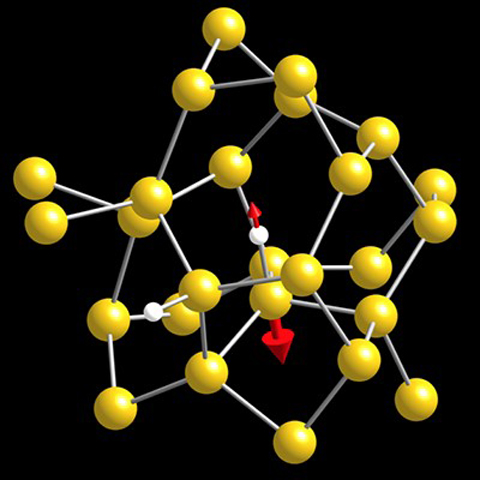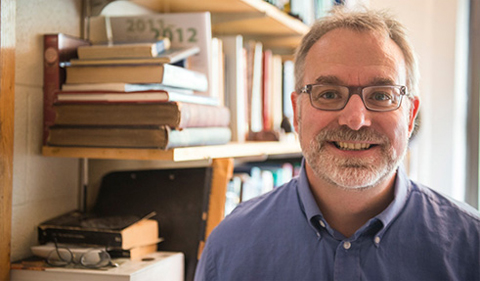
A high-frequency localized SiH stretching mode, with 99.2% stretching character, observed at 2001cm−1 in the a-Si:H model. Silicon and hydrogen atoms are shown in yellow and white colors, respectively. A pair of red arrows indicate the component of the vibrational eigenvector on the atoms.
A figure in an article co-authored by Dr. David Drabold was selected to be featured on the front page of Physical Review B in the Kaleidoscope section this month.
The article, “First-principles simulations of vibrational decay and lifetimes in a-Si:H and a-Si:D,” was published on March 21.
Drabold is Distinguised Professor of Physics & Astronomy at Ohio University. Co-authors are Raymond Atta-Fynn of the University of Texas, Stephen R. Elliott of the University of Cambridge, and Parthapratim Biswas of the The University of Southern Mississippi.
Biswas was a post-doc working with Drabold and also served as a Glidden Visiting Professor at Ohio University. Elliott is a long-time collaborator with Drabold. Three of the researchers—Atta-Fynn, Biswas and Drabold— currently share an NSF grant.
Abstract: Phonon lifetime in materials is an important observable that conveys basic information about structure, dynamics, and anharmonicity. Recent vibrational transient-grating measurements, using picosecond infrared pulses from free-electron lasers, have demonstrated that the vibrational-population decay rates of localized high-frequency stretching modes (HSMs) in hydrogenated and deuterated amorphous silicon (a-Si:H/D) increase with temperature and the vibrational energy redistributes among the bending modes of Si in a-Si:H/D. Motivated by this observation, we address the problem from first-principles density-functional calculations and study the time evolution of the vibrational-population decay in a-Si:H/D, the average decay times, and the possible decay channels for the redistribution of vibrational energy. The average lifetimes of the localized HSMs in a-Si:H and a-Si:D are found to be approximately 51–92 ps and 50–78 ps, respectively, in the temperature range of 25–200 K, which are consistent with experimental data. A weak temperature dependence of the vibrational-population decay rates has been observed via a slight increase of the decay rates with temperature, which can be attributed to stimulated emission and increased anharmonic coupling between the normal modes at high temperature.


















Comments